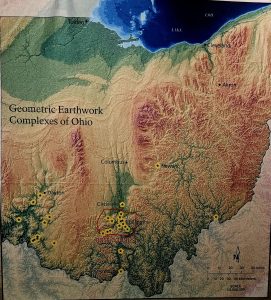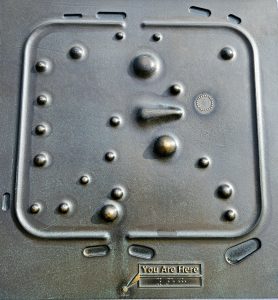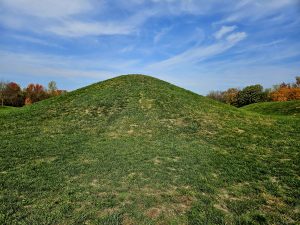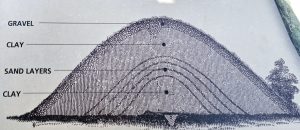Earthworks as architecture?
EARTHWORKS AS ARCHITECTURE?
M and I are road-tripping through Ohio, Tennessee, Mississippi, Missouri, and Iowa. Twelve days into our trip, I’ve finally had a day to write. While in Ohio, we visited the Hopewell Ceremonial Earthworks (See: https://hopewellearthworks.org/ ). I was fascinated!
When I think about architecture, I think about buildings made of wood or brick or glass. So, when the introductory film at Hopewell Ceremonial Earthworks called the earthwork mounds architecture, I was intrigued. Why would mounds of earth even qualify as architecture? The answer amazed me!
About 1,600 to 2,000 years ago Indigenous people inhabited southern and central Ohio and were the ancestors of today’s American Indians. They created “the largest concentration of geometric and monumental earthen architecture in the world. The traditions and achievements of these Indigenous people are today called ‘Hopewell’ —the name given by archeologists to this flowering in the Ohio Valley” (Guide to the Hopewell Ceremonial Earthworks, Third Edition 2023).
 The Indigenous people did not live at these sites, just as we do not live at our churches, or cemeteries, or public gathering spaces. They lived in small groups of family members spread out from each other. They would come together at the mounds to commemorate life’s events such as rites of passage and burials. These sites were places for feasts and places for prayer.
The Indigenous people did not live at these sites, just as we do not live at our churches, or cemeteries, or public gathering spaces. They lived in small groups of family members spread out from each other. They would come together at the mounds to commemorate life’s events such as rites of passage and burials. These sites were places for feasts and places for prayer.
There are multiple earthwork sites which are located miles from each other, but which are similar if not the same in architecture and dimensions. Most consist predominantly of a large circle, a small circle, and a triangle. These geometric shapes are aligned astronomically with the summer and winter solstices and the rising of the moon.
There are eight earthwork sites: Great Circle Earthworks (Heath, OH), Octagon Earthworks (Newark, OH), Hopewell Mound Group (Chillicothe, OH), Mound City (Chillicothe, OH), Hopeton Earthworks (Chillicothe, OH), High Bank Works (Chillicothe, OH), Seip Earthworks (Bainbridge, OH) and Fort Ancient (Oregonia, OH). High Banks is a research preserve and not open to the public except for scheduled events. Mound City is the location of the Visitor’s Center. M and I visited Mound City.

2. Photo from the interpretive sign looking forward.
Here are just a few photos of Mound City:

1. This image from the interpretive sign shows the layout of Mound City. Mound City is located near the Scioto River. This site does not display the typical geometric shape layout.

3. Mound 7. “The Hopewell people built their mounds with care as evidenced here at Mound 7– Central Mound–the largest of the Mound City Group. It was not just a matter of piling up dirt; layers of clay, sand, and gravel were sequenced in complex patterns. […] Thirteen cremated burials were uncovered in this mound, with many objects made of copper — mined 600 miles away near Lake Superior” (from Interpretive Signage at site).

4. Mound 7 cutaway


